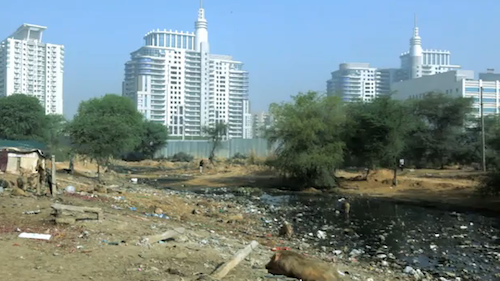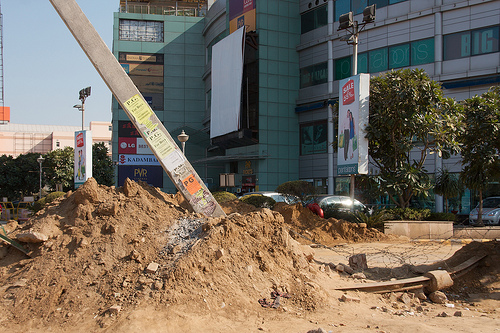 In Gurgaon, gleaming residences, malls, and office buildings are like islands unto themselves.Photo: iamgurgaonYou hear a lot of people talking these days about small government. About letting the free market drive development. About how city planners are trying to do some kind of sinister social engineering. About how the feds and the states should just stay out of the way and let business do its thing, and the economy would take off.
In Gurgaon, gleaming residences, malls, and office buildings are like islands unto themselves.Photo: iamgurgaonYou hear a lot of people talking these days about small government. About letting the free market drive development. About how city planners are trying to do some kind of sinister social engineering. About how the feds and the states should just stay out of the way and let business do its thing, and the economy would take off.
So what would that look like?
Well, it might look something like Gurgaon, India, a booming suburb about 15 miles from New Delhi that has flourished economically over the last 20 years by hosting outsourced business operations.
Gurgaon has lots of fancy shops and apartment buildings. But no functional citywide sewer system. No reliable public source of clean water. Erratic electricity. Inefficient or nonexistent garbage collection. Almost no public transportation.
According to a fascinating piece in The New York Times on Gurgaon, most of the city services that are planned and managed by the government in the United States and other countries are instead handled by private contractors, with corporations and individuals footing the bill:
To compensate for electricity blackouts, Gurgaon’s companies and real estate developers operate massive diesel generators capable of powering small towns. No water? Drill private borewells. No public transportation? Companies employ hundreds of private buses and taxis. Worried about crime? Gurgaon has almost four times as many private security guards as police officers….
Faced with regular power failures, [outsourcing company] Genpact has backup diesel generators capable of producing enough electricity to run the complex for five days (or enough electricity for about 2,000 Indian homes). It has a sewage treatment plant and a post office, which uses only private couriers, since the local postal service is understaffed and unreliable. It has a medical clinic, with a private ambulance, and more than 200 private security guards and five vehicles patrolling the region. It has A.T.M.’s, a cellphone kiosk, a cafeteria and a gym.
“It is a fully finished small city,” said Naveen Puri, a Genpact administrator.
Actually, it is a private island, one of many inside Gurgaon. The city’s residential compounds, especially the luxury developments along golf courses, exist as similarly self-contained entities. Nearly every major outsourcing company in the city depends on private infrastructure, as do the commercial towers filled with other companies.
The situation in Gurgaon, according to the Times, is complex. The place took off economically precisely because of the lack of a strong local government and the attendant red tape. Another nearby municipality with more structured governance and better infrastructure has lagged over the same period.
There is also a deep distrust in India of the ability of the government to make responsible use of financial resources or to make smart decisions. Corruption is rampant.
Leaving things to private corporations makes sense to a lot of people in this type of environment, at least to begin with — unless you’re too poor to pay the price, like the tens of thousands of people who live in Gurgaon’s shantytowns.
But it’s not just the poor who would like to see the government step up its involvement:
“We pretty much carry the entire weight of what you would expect many states to do,” said Pramod Bhasin, who this spring stepped down as Genpact’s chief executive. “The problem — a very big problem — is our public services are always lagging a few years behind, but sometimes a decade behind. Our planning processes sometimes exist only on paper.”
There is evolving creative citizen involvement in Gurgaon. A group called “iamgurgaon” is cleaning up garbage, getting out the vote for a new municipal council that will for the first time provide more centralized oversight, planting trees, and planning a much-needed park.
 This photographer wrote, “Typical Gurgaon. Just outside a very expensive mall you find this sort of ridiculous roadworks / development. There seems to be a general disregard for the surroundings or environment as soon as they are not under your ownership.”Photo: Bruce Thomson
This photographer wrote, “Typical Gurgaon. Just outside a very expensive mall you find this sort of ridiculous roadworks / development. There seems to be a general disregard for the surroundings or environment as soon as they are not under your ownership.”Photo: Bruce Thomson
Such public/private community-driven efforts have a lot in common with the evolving approach of Tactical Urbanism, or with the international WikiCity movement, in which citizens perform guerrilla infrastructure interventions like painting crosswalks where they are needed. Some of these methods make sense especially where the economy is not booming.
But whether you’re in a boom or a bust, in the best-case scenario, there’s a governing structure in place that can respond to creative citizen and corporate involvement, allowing a city’s people to experiment and suggest improvements based on street-level understanding of their communities, which can then be made permanent. Increasingly, this is a model that is being replicated and scaled.
I have never been to Gurgaon. Have any of you? I’m interested in hearing more about it.




